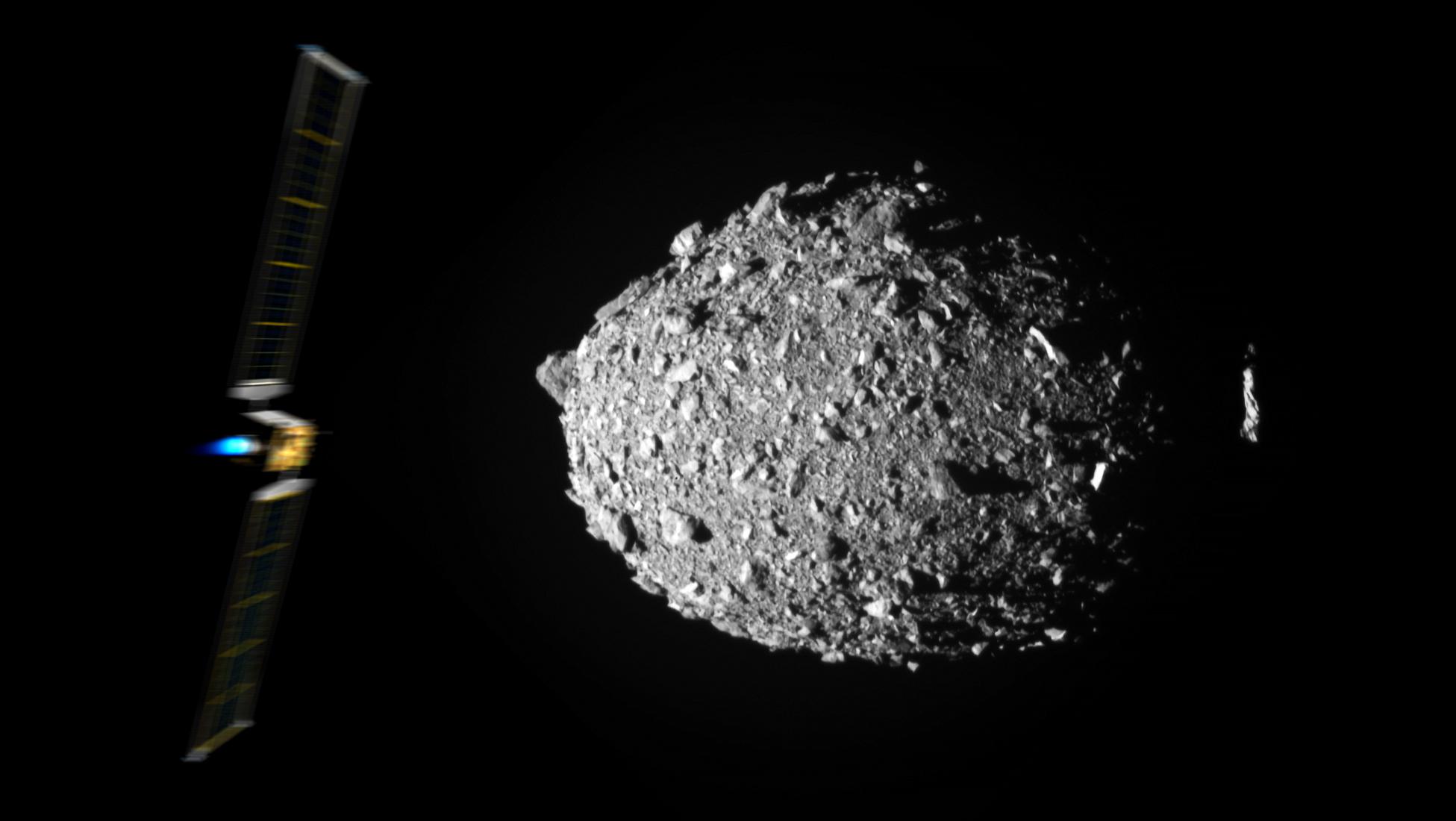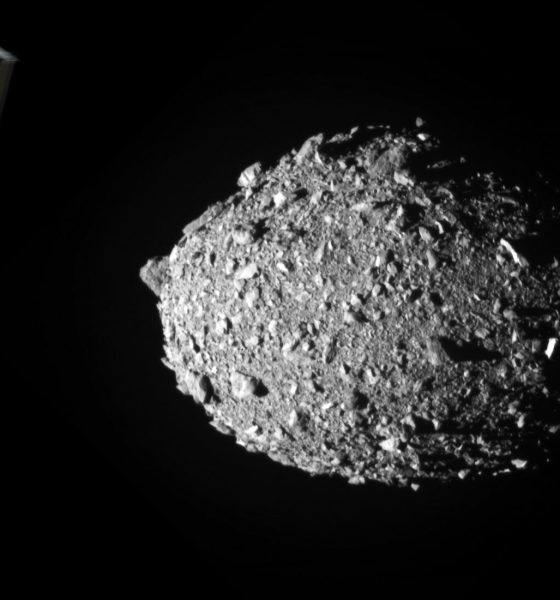

News
NASA spacecraft successfully slams into asteroid ten months after SpaceX launch
Ten months after launching into interplanetary space on a SpaceX Falcon 9 rocket, NASA’s Double Asteroid Redirect Test (DART) spacecraft has successfully impacted an asteroid moon.
Falcon 9 lifted off from Vandenberg Space Force Base (VSFB) Space Launch Complex 4 (SLC-4) carrying the 630-kilogram (~1400 lb) spacecraft on November 24th, 2021. The rocket performed flawlessly, continuing a streak of successful launches, and boosted DART on its way to a near-Earth asteroid pair.
The goal: slam into the small asteroid moon Dimorphos at an eyewatering speed of 6.3 kilometers per second (14,000 mph / Mach 18). Ten months later, the spacecraft has accomplished exactly that, successfully crashing into a target about 160 meters (530 ft) wide just 17 meters away from a perfect ‘bullseye’ after traveling for ten months and hundreds of millions of kilometers through space. Depending on the results NASA and dozens of other groups will now attempt to glean from ground and space telescopes, the successful impact could be a major leap forward for the field of planetary defense.
The main goal of planetary defense is to protect humanity’s home planet from asteroids, a threat that has routinely caused mass-extinction events throughout the multibillion-year history of life on Earth. With the technology to both detect and reach virtually all near-Earth objects (NEOs) more or less at hand, DART is the first attempt to test and verify what would seem to be the easiest and most obvious method of redirecting asteroids: knocking them off course with the spacecraft itself.
Planetary science and the behavior of things in microgravity conditions have a tendency to defy expectations, however, so testing that assumption is essential. The perfect way to do so came to DART Lead Investigator Andy Chang in a burst of mid-exercise inspiration: instead of hitting any odd NEO, a small spacecraft could slam into a tiny asteroid moon of a much larger parent asteroid. Hitting an asteroid moon would mitigate the small but nonzero risk of accidentally redirecting the target towards Earth while also amplifying the results, making them much easier to observe from tens of millions of kilometers away.
Rather than being forced to search for a virtually imperceptible change in a single asteroid’s half-billion-kilometer-long orbit, the results of hitting the right asteroid moon would be much more easily detectable as a change in the moon’s much smaller orbit around its untouched parent asteroid.
The problem is that aside from spectrographic readings that tell scientists the broad strokes of an asteroid’s composition and other telescope images that can make out the rough shape, it’s very difficult to scout the objects without actually visiting them. And given the difficulty, spacecraft have only visited a handful of the virtually countless asteroids of our solar system. Without knowing exactly what a target asteroid’s surface and subsurface are like, it’s hard to predict exactly what a spacecraft impacting that asteroid will do. A looser surface, which is what most visited asteroids appear to have, would be much worse at momentum transfer than a boulder or relatively solid surface of rock.
As an example, as DART rapidly approached and revealed more detailed views of the surface of Didymos and Dimorphos in its final minutes, Chang himself was surprised to see just how rough and boulder-strewn the surface of both asteroids were. Then, after the spacecraft impact, many scientists were also surprised to almost immediately see a massive cloud of dust – easily visible from ground-based telescopes – ejected from Dimorphos.
Despite the DART spacecraft’s eventful demise, the fun has only just begun on the ground as scientists attempt to solve that riddle (and many others) and begin searching for changes in Dimorphos’ orbit. Data will soon arrive from even larger and more prestigious observatories, including NASA’s space-based Hubble and Webb Space Telescopes. Italian companion cubesat LICIACube, which deployed from DART shortly before impact, will also downlink images it took up close, potentially offering the most detailed view of the impact for years.
Meanwhile, the European Space Agency (ESA) is developing a spacecraft called Hera that will launch in 2024 and attempt to enter orbit around Didymos and Dimorphos as early as late 2026 to examine the aftermath of DART’s last stand in even greater detail.
In the more distant future, particularly if the international science community ultimately concludes that DART did successfully redirect an asteroid (moon), it’s possible that the mission will help to kickstart an entirely new global project and fleet of spacecraft that will stand ready to protect Earth if the need ever truly arises. With a little luck and a modest amount of government funding, humanity may soon be able to entirely eradicate one of the most infamous sources of mass extinction.

News
Tesla hints at Starlink integration with recent patent
“By employing polymer blends, some examples enable RF transmission from all the modules to satellites and other communication devices both inside and outside the vehicle.”

Tesla hinted at a potential Starlink internet terminal integration within its vehicles in a recent patent, which describes a vehicle roof assembly with integrated radio frequency (RF) transparency.
The patent, which is Pub. No U.S. 2025/0368267 describes a new vehicle roof that is made of RF-transparent polymer materials, allowing and “facilitating clear communication with external devices and satellites.”
Tesla believes that a new vehicle roof design, comprised of different materials than the standard metallic or glass elements used in cars today, would allow the company to integrate modern vehicular technologies, “particularly those requiring radio frequency transmission and reception.
Tesla has recently filed a US patent application on integrating RF transparent materials into the roof structure.
“facilitating clear communication with external devices and satellites”
Tesla fleet is getting @Starlink connectivity integration soon. LFG @Tesla @elonmusk… pic.twitter.com/bLa8YtPLd1
— Chansoo Byeon (@Chansoo) December 9, 2025
Instead of glass or metallic materials, Tesla says vehicles may benefit from high-strength polymer blends, such as Polycarbonate, Acrylonitrile Butadiene Styrene, or Acrylonitrile Styrene Acrylate.
These materials still provide ideal strength metrics for crashworthiness, stiffness for noise, vibration, and harshness control, and are compliant with head impact regulations.
They would also enable better performance with modern technologies, like internet terminals, which need an uninterrupted signal to satellites for maximum reception. Tesla writes in the patent:
“By employing polymer blends, some examples enable RF transmission from all the modules to satellites and other communication devices both inside and outside the vehicle.”

One of the challenges Tesla seems to be aware of with this type of roof design is the fact that it will still have to enable safety and keep that at the forefront of the design. As you can see in the illustration above, Tesla plans to use four layers to increase safety and rigidity, while also combating noise and vibration.
It notes in the patent that disclosed examples still meet the safety requirements outlined in the Federal Motor Vehicle Safety Standards (FMVSS).
Starlink integrated directly into Tesla vehicles would be a considerable advantage for owners. It would come with a handful of distinct advantages.
Initially, the inclusion of Starlink would completely eliminate cellular dead zones, something that is an issue, especially in rural areas. Starlink would provide connectivity in these remote regions and would ensure uninterrupted service during road trips and off-grid adventures.
It could also be a critical addition for Robotaxi, as it is crucial to have solid and reliable connectivity for remote monitoring and fleet management.
Starlink’s growing constellation, thanks to SpaceX’s routine and frequent launch schedule, will provide secure, stable, and reliable internet connectivity for Tesla vehicles.
Although many owners have already mounted Starlink Mini dishes under their glass roofs for a similar experience, it may be integrated directly into Teslas in the coming years, either as an upgrade or a standard feature.
News
Tesla supplements Holiday Update by sneaking in new Full Self-Driving version
It seems Tesla was waiting for the Hardware 4 rollout, as it wanted to also deploy a new Full Self-Driving version to those owners, as it appeared in the release notes for the Holiday Update last night.

Tesla has surprised some owners by sneaking in a new Full Self-Driving version with the wide release of the Holiday Update, which started rolling out to Hardware 4 owners on Friday night.
Tesla has issued a controlled and very slow release pattern with the Holiday Update, which rolls out with Software Version 2025.44.25.5.
For the past two weeks, as it has rolled out to Hardware 3 and older Tesla owners, the company has kept its deployment of the new Software Version relatively controlled.
It seems Tesla was waiting for the Hardware 4 rollout, as it wanted to also deploy a new Full Self-Driving version to those owners, as it appeared in the release notes for the Holiday Update last night.
Tesla Full Self-Driving v14.2.1.25 made its first appearance last night to Hardware 4 owners who are members of the Early Access Program (EAP). It appears to be a slight refinement from FSD v14.2.1, which has been out for a couple of weeks.
Tesla v2025.44.25.5 Holiday update incoming
Also Full Self-Driving v14.2.1.25!!! pic.twitter.com/74D7S0UGXz
— TESLARATI (@Teslarati) December 13, 2025
Many owners welcome the new FSD version, us included, because we’ve been less than impressed with v14.2.1. We have experienced some minor regressions with v14.2.1, especially with Speed Limit recognition, Speed Profile tinkering, and parking performance.
As it stands, Full Self-Driving is still particularly impressive, but Tesla is evidently having an issue with some of the adjustments, as it is still refining some of the performance aspects of the suite. This is expected and normal with some updates, as not all of them are an improvement in all areas; we routinely see some things backtrack every once in a while.
This new FSD version is likely to take care of those things, but it also includes all of the awesome Holiday Update features, which include:
- Grok with Navigation Commands (Beta) – Grok will now add and edit destinations.
- Tesla Photobooth – Take pictures inside your car using the cabin-facing camera
- Dog Mode Live Activity – Check on your four-legged friend on your phone through periodic snapshots taken of the cabin
- Dashcam Viewer Update – Includes new metrics, like steering wheel angle, speed, and more
- Santa Mode – New graphics, trees, and a lock chime
- Light Show Update – Addition of Jingle Rush light show
- Custom Wraps and License Plates – Colorizer now allows you to customize your vehicle even further, with custom patterns, license plates, and tint
- Navigation Improvements – Easier layout and setup
- Supercharger Site Map – Starting at 18 pilot locations, a 3D view of the Supercharger you’re visiting will be available
- Automatic Carpool Lane Routing – Navigation will utilize carpool lanes if enabled
- Phone Left Behind Chime – Your car will now tell you if you left a phone inside
- Charge Limit Per Location – Set a charge limit for each location
- ISS Docking Simulator – New game
- Additional Improvements – Turn off wireless charging pad, Spotify improvements, Rainbow Rave Cave, Lock Sound TRON addition
Tesla also added two other things that were undocumented, like Charging Passport and information on USB drive storage to help with Dashcam.
Cybertruck
Tesla updates Cybertruck owners about key Powershare feature

Tesla is updating Cybertruck owners on its timeline of a massive feature that has yet to ship: Powershare with Powerwall.
Powershare is a bidirectional charging feature exclusive to Cybertruck, which allows the vehicle’s battery to act as a portable power source for homes, appliances, tools, other EVs, and more. It was announced in late 2023 as part of Tesla’s push into vehicle-to-everything energy sharing, and acting as a giant portable charger is the main advantage, as it can provide backup power during outages.
Cybertruck’s Powershare system supports both vehicle-to-load (V2L) and vehicle-to-home (V2H), making it flexible and well-rounded for a variety of applications.
However, even though the feature was promised with Cybertruck, it has yet to be shipped to vehicles. Tesla communicated with owners through email recently regarding Powershare with Powerwall, which essentially has the pickup act as an extended battery.
Powerwall discharge would be prioritized before tapping into the truck’s larger pack.
However, Tesla is still working on getting the feature out to owners, an email said:
“We’re writing to let you know that the Powershare with Powerwall feature is still in development and is now scheduled for release in mid-2026.
This new release date gives us additional time to design and test this feature, ensuring its ability to communicate and optimize energy sharing between your vehicle and many configurations and generations of Powerwall. We are also using this time to develop additional Powershare features that will help us continue to accelerate the world’s transition to sustainable energy.”
Owners have expressed some real disappointment in Tesla’s continuous delays in releasing the feature, as it was expected to be released by late 2024, but now has been pushed back several times to mid-2026, according to the email.
Foundation Series Cybertruck buyers paid extra, expecting the feature to be rolled out with their vehicle upon pickup.
Cybertruck’s Lead Engineer, Wes Morrill, even commented on the holdup:
As a Cybertruck owner who also has Powerwall, I empathize with the disappointed comments.
To their credit, the team has delivered powershare functionality to Cybertruck customers who otherwise have no backup with development of the powershare gateway. As well as those with solar…
— Wes (@wmorrill3) December 12, 2025
He said that “it turned out to be much harder than anticipated to make powershare work seamlessly with existing Powerwalls through existing wall connectors. Two grid-forming devices need to negotiate who will form and who will follow, depending on the state of charge of each, and they need to do this without a network and through multiple generations of hardware, and test and validate this process through rigorous certifications to ensure grid safety.”
It’s nice to see the transparency, but it is justified for some Cybertruck owners to feel like they’ve been bait-and-switched.








